

The squirrel is among North America’s five most common rodents, alongside chipmunks, gophers, deer mice, and beavers. As such, it’s fairly common to find them in residential areas and suburbs with plenty of trees and plants. You might see one darting across your yard or hear them scurrying about in your home. Also, like gophers, squirrels can cause much damage around your home if left to their devices. So, if you’ve encountered the pests, the question, “how to get rid of squirrels,” is bound to show up in your search history. Fortunately, there are several countermeasures you can employ depending on the situation, as discussed below.
There are at least 200 squirrel species scattered worldwide, with a few native to the United States. They can be harder to identify since different species have different features. For instance, the color of their fur can be red, brown, gray, or even black. Additionally, their size ranges anywhere from 3.9 to 27.6 inches.
Squirrels can live either on the ground or in trees, and while it’s fair to say that all species have bushy tails, you will notice a difference between ground-dwelling and tree-dwelling squirrels. The former has thinner tails. It’s also worth noting that squirrel tails are multi-purpose. They help balance the squirrel when climbing trees and can be used to provide shade or warmth depending on ambient temperatures.
Ground squirrels, as implied by the name, build burrows and typically hibernate through winter. On the other hand, their tree-dwelling counterparts choose to build nests on tree branches. They may also live within tree hollows and tend to be active year-round.
Another common feature for squirrels is that they have longer hind limbs than front limbs. Also, they can have four to five toes and typically have poorly developed thumbs on their front paws. Lastly, despite some species living underground, most squirrels have large visible eyes.
Notably, some squirrel species, like the eastern gray squirrel, burry acorns when the weather starts to get chilly. According to the Smithsonian, some even dig up and rebury their nuts with other squirrels trying to steal the nuts. Also, these squirrels often forget where they buried their nuts, with some scientists believing it results in oak forest regeneration.
The type of squirrel you encounter in or around your home will depend on your location since different species thrive in different environments. The most common in the U.S. are gray squirrel, ground squirrel, red squirrel, and fox squirrel. That said, you may also see the occasional flying squirrel.
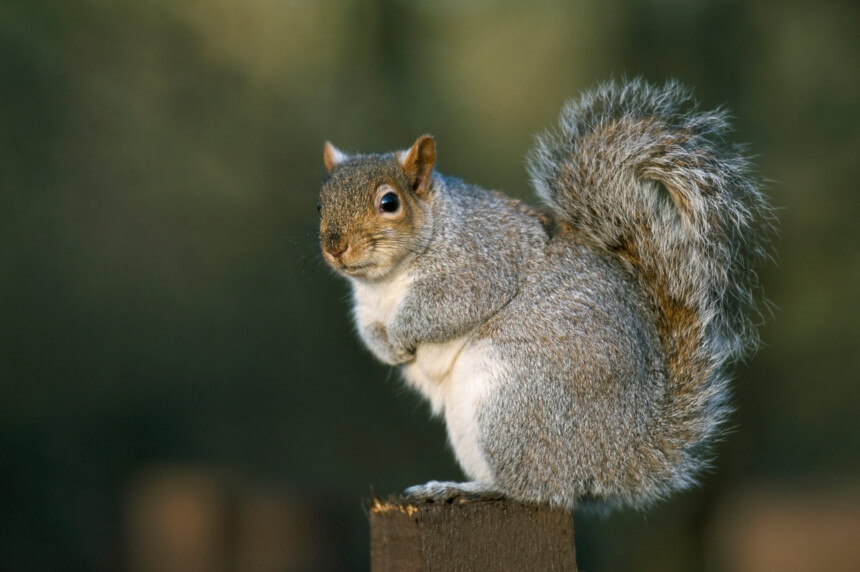
Like beavers, squirrel incisors keep growing throughout their life, and the consistent gnawing is an attempt at keeping their size in check. As such, it’s no surprise that they’ll chew into electrical wiring when they don’t have an acorn to bite into.
Nevertheless, the eastern gray squirrel has a grayish body, as the name implies. Additionally, you may notice some black, white, or brown fur. Lastly, they have a whitish belly. It’s possible to encounter some that are completely black, although this is attributed to melanism.
Being tree dwellers, the eastern gray squirrels have bushy tails that vary in color from a pale gray to brownish. Also, the species can grow to 20 inches with a 1.5-pound weight.
The western gray squirrel is much easier to identify with their silvery-gray backs and pure white bellies. They also have long, bushy, blackish-gray tails with white edges. The population is low enough that you often don’t have to worry about these species moving into your backyard. In fact, they’ve made it onto the International Union for Conservation of Nature’s red list of threatened species, although the concern of them going extinct is fairly low.
The size of the western gray squirrel ranges from 18-24 inches, with the weight ranging from 0.7 to 2 pounds.
Both eastern and western gray squirrels are solitary by nature and will not hibernate during winter. The eastern gray squirrel is also likely to carry fleas, ticks, lice, and other parasites that can spread diseases to humans.
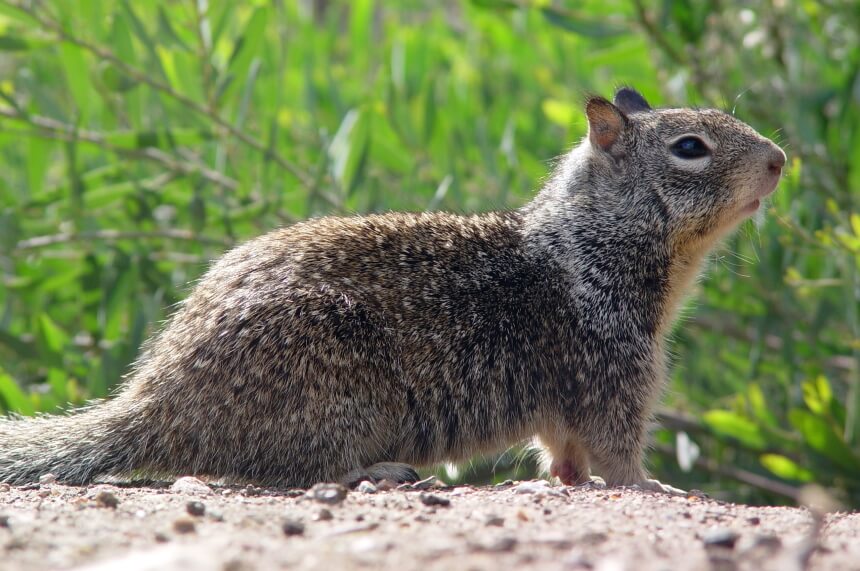
The critter grows to about 17.9 inches long, including the tail, with the body roughly 12 inches. Given that they’re ground squirrels, these species will dig burrows and are communal creatures, so you may find a few in each burrow. That said, each squirrel will have their own entrance.
They’re considered pests in gardens and even parks due to their affinity for ornamental plants and trees. While they’re mostly herbivores, they can eat insects such as grasshoppers. You can also find them stuffing more food than they can eat in their cheek pouches so they can take it to their burrows for storage.
Ground squirrels hibernate in the cold but can also be active year-round, depending on the location and how cold it gets. Additionally, their mating season is in early spring, with resulting litters consisting of five to eleven kits.
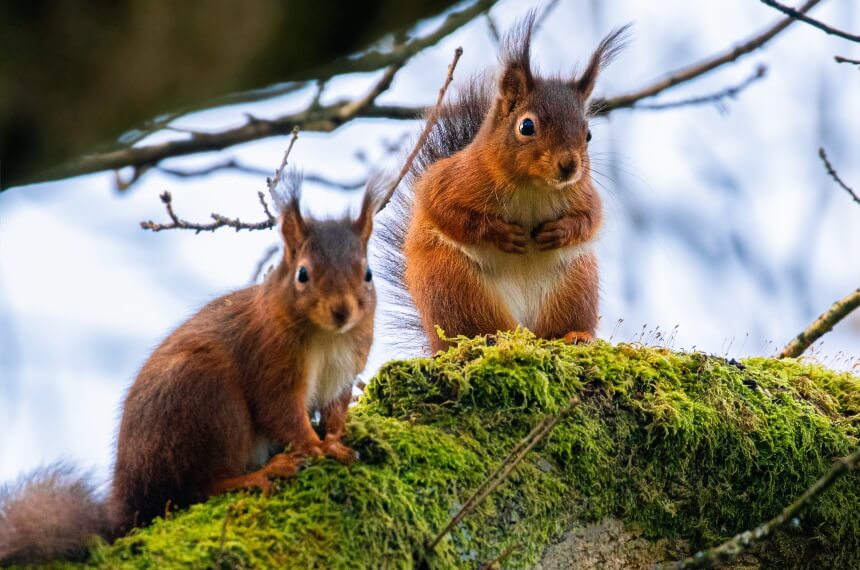
Also, while they do not hibernate, they can go dormant during the cold season. Lastly, they’re quite widespread in North America and can be found in Alaska, some sections of Georgia, and the Rocky Mountains.
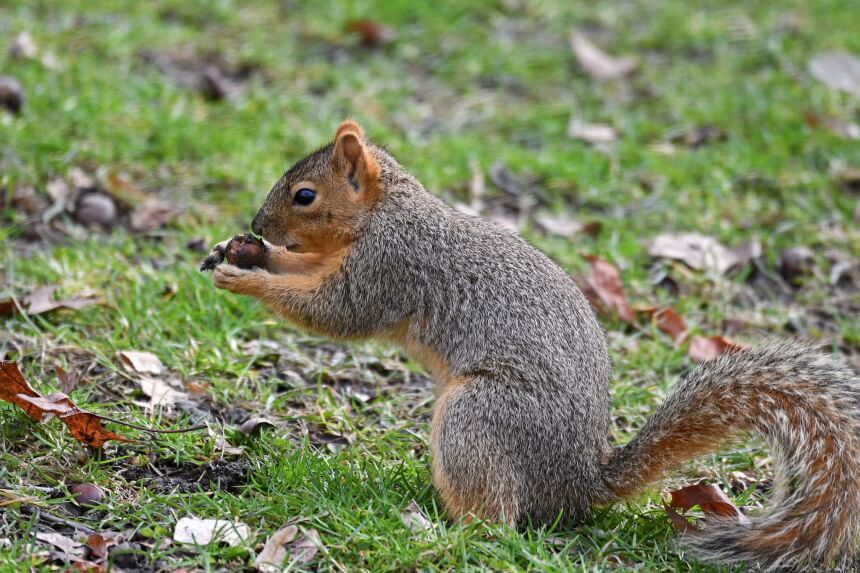
Additionally, they need large trees with holes to build nests for hibernation and breeding. They can also build leaf nests higher up in the trees. Fox squirrels are widespread between south-central Canada and northeastern Mexico.
Lastly, fur colors are their most varied feature. Some are pale gray, while others are outright black with grey feet. Nevertheless, the most common fox squirrels have reddish-brown fur. Also, belly fur is typically a lighter color.
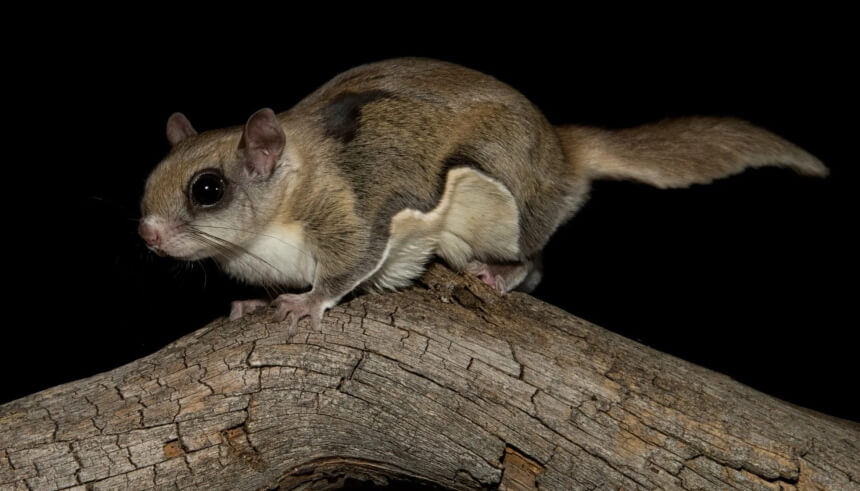
Other physical characteristics include dense fur and large eyes. Most species in the U.S. are between 8 and 12 inches long and can glide up to 160 feet in the air. That said, giant flying squirrels have been recorded gliding up to about 1500 feet in other parts of the world. This is made possible by loose skin and muscle that forms a fur-covered membrane between the front and hind limbs.
Depending on the species and its habits, squirrels can do much damage in and around your property. For species that live on trees, chewed-up and damaged power lines may be rare, but they can happen. The squirrels typically live above the power utility lines, and when they give birth, their kits can use the lines to keep their incisors in check. If they chew through the outer wire covering, you could be saddled with a huge repair bill.
Also, the squirrels may use the utility lines to traverse from one property to the next or from one tree to the next. The resulting strain on fasteners that hold the lines in place can lead to the wires drooping over time. They can also damage rooftop wiring in your home.
Additionally, they can create holes in your attic or walls. Their curiosity may lead them to try and explore your home, and one way to do that is to chew through the wall. If they do that, they might accidentally chew through an electrical wire, and while that often spells their untimely demise, it also means you’ll have to pay up for electrical repairs.
Furthermore, once they gain access to your attic, they can cause even more damage. They can leave holes in your fiberglass insulation or pee and leave droppings that will cost you to clean up. Also, with the reduced insulation, your HVAC system won’t be as efficient, meaning a higher electrical bill.
As for ground squirrels, they’re more likely to dig holes in your yard and eat the contents of your vegetable garden. After all, they are mostly herbivores.
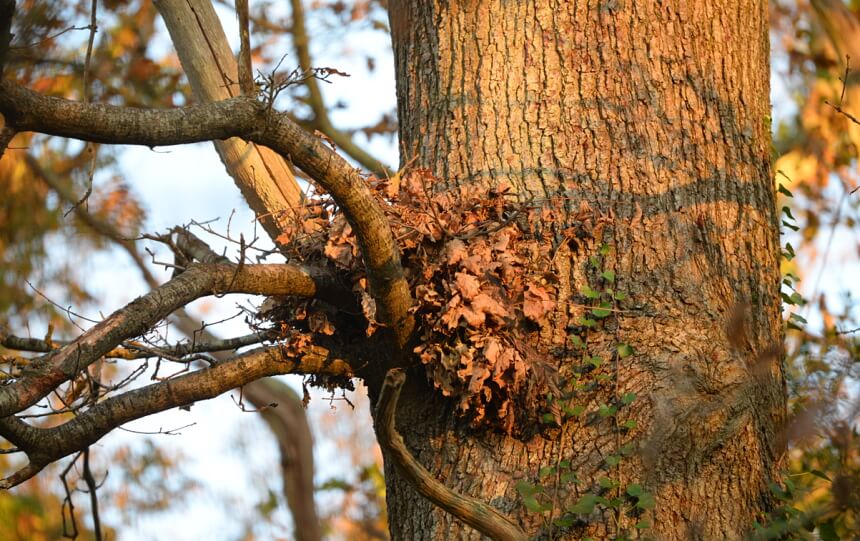
Dreys are built using clumped-up collections of twigs, leaves, bark, and moss, among other materials. They look like small round bulbs of bunched-up leaves, especially since they’re often 20 feet or higher up in trees. However, they range from 6 to 8 inches in diameter and can even be confused for birds’ nests if you’ve never seen one before.
If there aren’t enough materials, the dreys can even consist of paper, wood, or garbage, depending on what’s available. Also worth noting is that squirrel nests incorporate the shape of the branches around them for better protection against the elements. As such, it’s more common to find them in branch forks.
If possible, the squirrel will also make a home in tree hollows for extra warmth and protection from the elements. Lastly, some build burrows. The length of the squirrel burrow can range between 5 and 30 feet, with most burrow systems being under 3 feet from the ground’s surface. However, some can be more than 6 feet deep.
Also, it’s possible to have either single tunnel or complex multi-tunnel burrows.
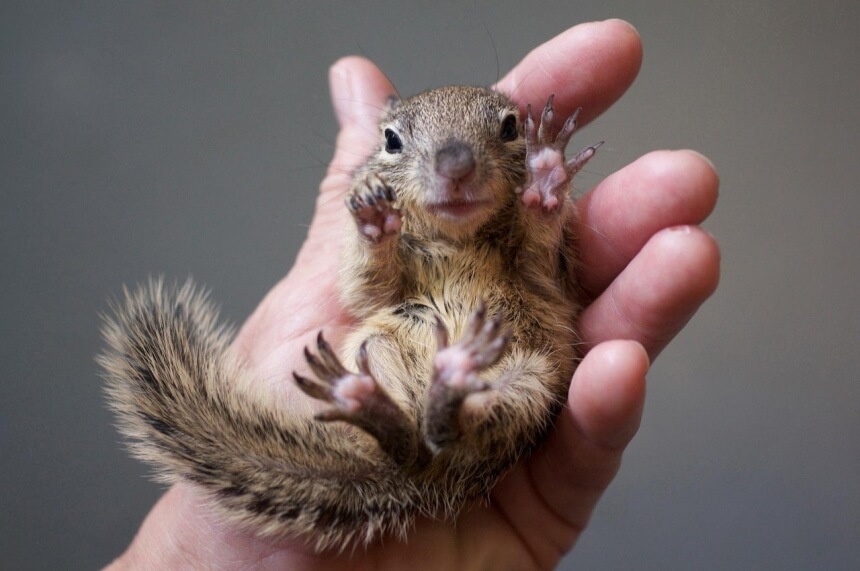
In other periods of the year, gray squirrels are most active in the 2-3 hour period after dawn and before dusk. The rest of the day is spent resting in their nests or basking in the sun on tree branches. That said, heavy clouds can extend their usual activity periods during the day.
There are two mating seasons, with one occurring during late winter while the other is in mid-summer. During this time, you’ll typically find 1-10 males trying to mate with the female, and often the most dominant one gets the honor. However, there are exceptions. Females that just turned a year old can give birth once, while their older counterparts can have up to two litters annually.
After that, there’s a 40-44 day gestation period with litters consisting of 1 to 9 kits per litter. However, the average is often 2 or 3, according to the SUNY College of Environmental Science and Forestry. The kits open their eyes at between 28 and 35 days. They should also start exploring outside their mother’s nest at 42-49 days after birth.
Females wean their kits at 56-70 days, with the young squirrels leaving their mother’s nest for good. That said, litters born in late summer may stay throughout the winter before dispersing.
Mating for red squirrels is similar with a 36-40 day gestation period. However, the kits start opening their eyes on day 27 and have a full coat of fur by day 30. They start venturing outside soon after and should be establishing their own territories between 9 and 11 weeks of age.
Ground squirrels are a little different. They’re active during the day and will spend their time grooming, dust-bathing, sunning, or feeding. You might even see them lie with their bellies on the ground with their forearms extended and heads raised. While they live in colonies, they typically don’t socialize with each other. However, they will sound the alarm if they perceive danger.
These squirrels may hibernate for several months, depending on whether the area experiences snow. Also, if the temperatures get too hot during the summer, ground squirrels can estivate, where they’re dormant for several days at a time.
Nevertheless, fall is the most active period for squirrels as they can sense winter approaching. They’ll breed in late winter and late spring, typically producing two litters of young ones annually.
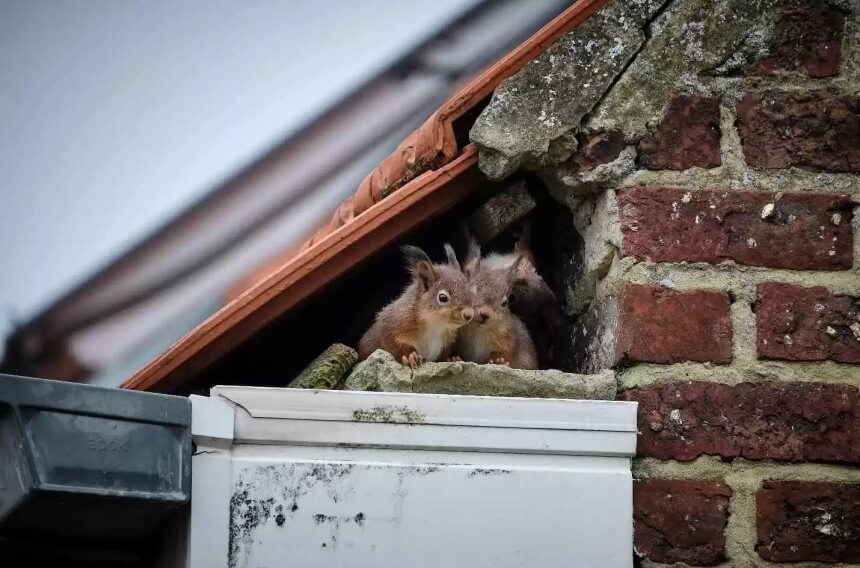
Furthermore, you might spot a nest or two in the trees around your property. If these trees have branches that are within 8 to 10 feet of your roof, then it’s even more likely that the critters you hear scampering on your roof are, in fact, squirrels.
They could also damage bird feeders as they’re looking for food, and lastly, you might spot them fighting if the population is high.
If they get inside your home, you will likely hear them scampering in your attic or inside walls. Also, given their gnawing tendencies, holes in insulation, siding, or under soffits indicate squirrel damage. Of course, if they spend a lot of time in your attic, they’re likely to leave droppings there as well.
Sounds of activity during the day indicate gray or fox squirrels depending on your location. On the other hand, flying squirrels are more active at night.
Both red and gray squirrels are classified as game animals which means you’re allowed to kill them for food. However, you need to have a valid hunting license before doing so. Depending on the city, there could be other limitations, e.g., you may not be allowed to shoot your gun within city limits, or you can’t use a pellet gun to kill the critters. In California, you also need a permit to trap squirrels.
Consequently, if you don’t have a hunting license, you may need to look into how to get rid of squirrels naturally. Also, waiting in your yard all day for a chance to shoot at a moving target isn’t the most efficient way to get rid of squirrels.
If you’d rather not kill the squirrels, there are ways to eliminate them humanely, as listed below.
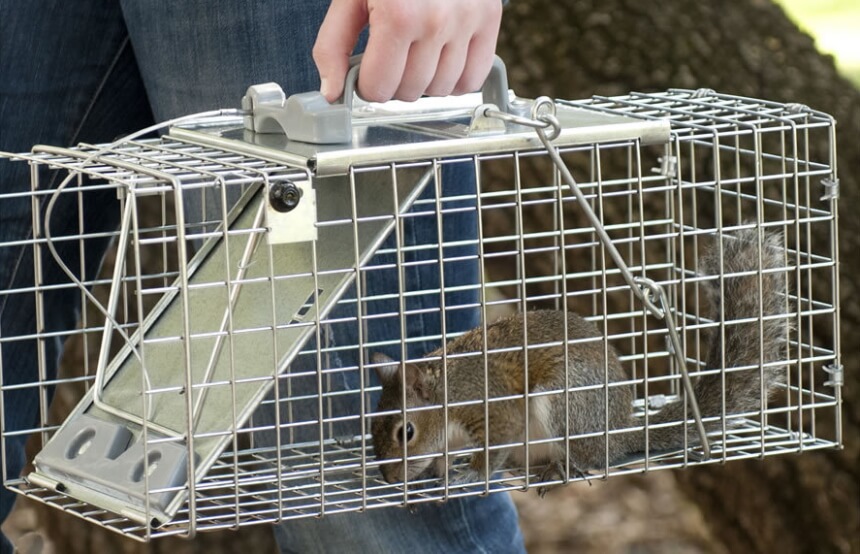
Live traps allow you to handle the squirrel with care while transporting it to the release site. The best live squirrel traps have enough space for the critter inside and allow the door to slam shut without harming the animal. They also work better when you’ve identified areas that the critters frequent. For instance, if you’ve heard squirrels frolicking in your attic and have also found droppings, there’s a good chance the rodent will return.
All that remains is to set the trap. Step one of that process includes choosing suitable bait. Peanuts, peanut butter, and orange slices are all great bait options you may already have at home. However, commercial baits may be more effective due to their strong aromas, which attract the rodents.
Place the bait inside the trap and ensure the spring mechanism works so the door closes behind the squirrel. Step three involves checking the trap periodically or at least twice a day. While the traps are designed to keep the squirrels safe, the creatures can harm themselves trying to get out.
Additionally, if you leave the trap for too long, there’s a good chance the bait will go bad and not be as effective, or a squirrel will die there from starvation.
Once the squirrel is trapped, you need to release it somewhere far from your residence, preferably in a park with the right habitat for the animal.
Finally, after using the trap, clean it thoroughly just in case the squirrel carried any other parasites. Also, you might need to use the live trap more than once, depending on the size of the infestation.
A benefit of using live traps is that you help conserve wildlife. Additionally, you needn’t deal with cleaning and burying squirrel corpses caught in the trap. On the other hand, transporting the critters to the release site, which may be more than half an hour away, can be a chore. Furthermore, squirrels can scratch and bite you as you’re trying to release them.
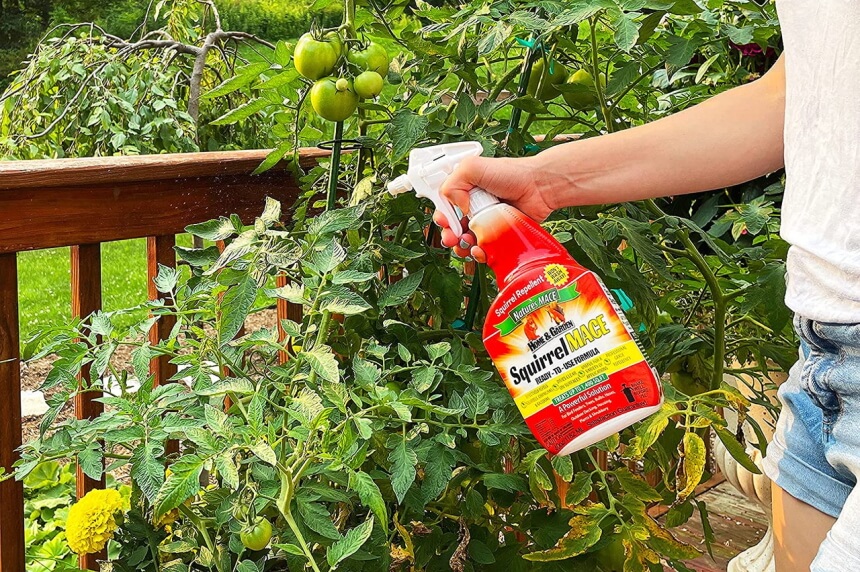
Notably, if you use a chemical repellent at one of the squirrel’s entry points into your home, it’s good to ensure the animal is out before application. After that, you can spray or scatter the repellent around the trees, plants, and entryways into your home.
Like the live traps, this has the advantage of being a humane way to get rid of the rodents. Additionally, you won’t have to come into contact with the squirrels. That said, some chemical repellents can be washed away by the rain. Another con is that you may need frequent reapplication to get rid of the squirrels for good.
Despite being harmless to squirrels, chemical repellents may have other unintended consequences on the environment. As such, some people may choose to use natural repellents instead. Some of these natural repellents are listed below.

Once spread in your plant garden, the mulch should prevent weed growth and make it harder for squirrels to dig into the ground. Consequently, you’re less likely to have ground squirrels venturing into your garden.


Alternatively, you can mix peppermint oil with hot water. Put the liquid solution in a spray bottle after it has cooled and apply it to your plants, around trees, and in your attic.



You can strategically place any of these plants around the trees in the yard or at entry points to your home. That said, some options like daffodils contain poisons, so if you have toddlers in your home with a habit of putting everything in their mouths, it may not be such a good idea.


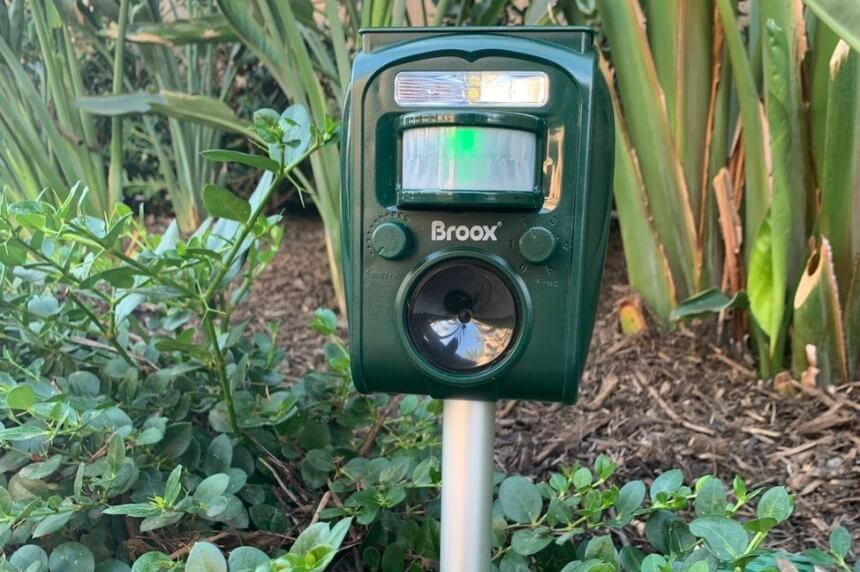
The gadgets emit sounds that are too high-pitched for human ears but are annoying for creatures like gophers and squirrels. Most of these deterrents are motion activated and can either be powered by solar or batteries.
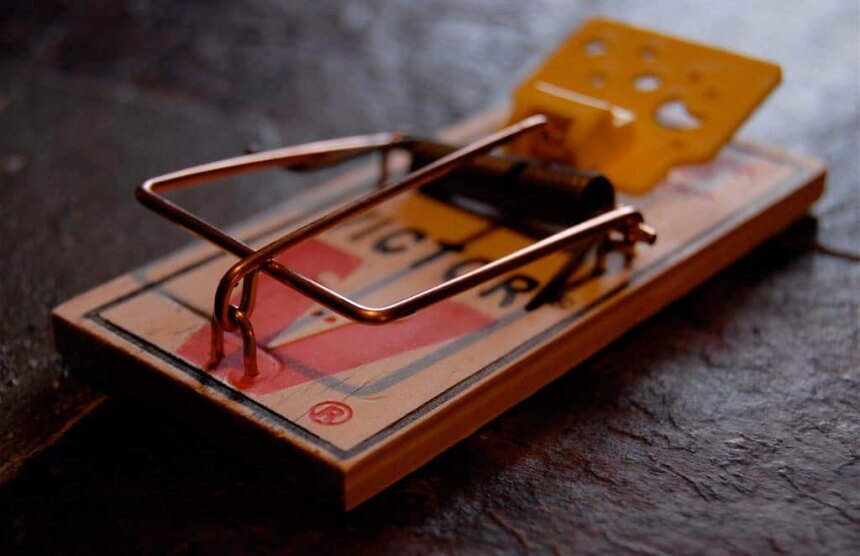
Once the squirrels scamper through and set off the trap, the loud noise and sudden movement in the ground near them will scare them off. If this happens enough times on your property, the animal will eventually learn to avoid your yard altogether.

It’s not advisable to leave your pets outdoors all day, although you can let them out several times a day until your squirrel problem is gone. If you allow them out randomly, it may serve to reinforce the idea that they’re always around for the squirrels.
Cats and dogs also mark their territory by peeing in the yard. Just the smell of that is enough to tell the squirrel that there’s a predator around. This is why some of the commercial repellents contain predator urine.
If you don’t have a pet, you can buy some of these predator-based repellents and spray them around the fence. However, given their awful smells, spraying near the house is ill-advised.
Lastly, you can add predator-bird figures on your roof or around the yard. They are more effective if they move erratically, so it would help if they’re light enough to sway in the wind.

An above-ground fence won’t be enough if your area is more likely to have ground squirrels. Instead, you’ll need to dig underground and line the area under the fence with chicken wire.

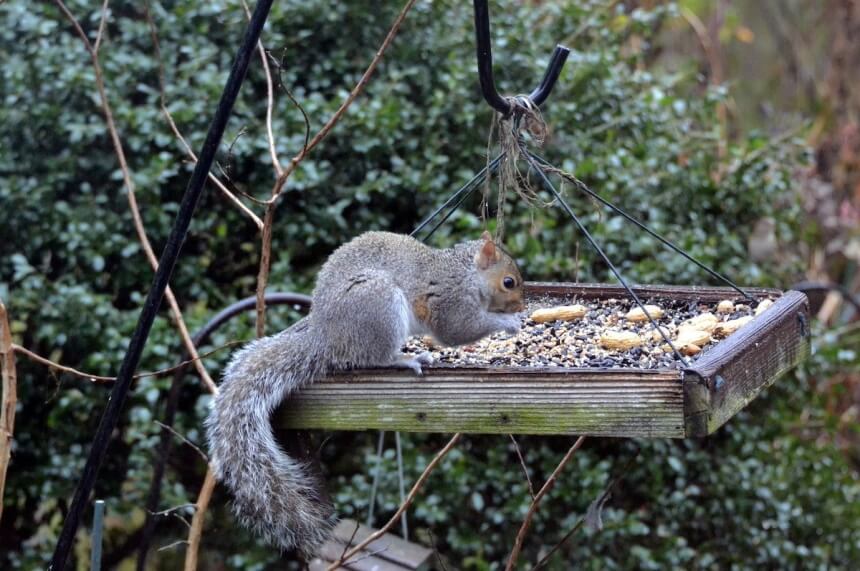
You can pick a spot right in the middle of the trees in your yard and fill the feeder with things they like including nuts and fruits. Additionally, it should be placed close enough to the ground to be accessible to ground squirrels.

Nevertheless, you don’t want to deal with a cornered squirrel since they can get aggressive. As such, start by turning on the lights and leaving a speaker there as a deterrent. You can also use ultrasonic deterrents if you’d rather not make noise for the household. After a few days, it should be fine to get in there and clean out everything with bleach and detergents.
Cleaning during the day is preferable since most squirrels will likely be out looking for food. On the other hand, a nest could spell trouble since it means the presence of pups. If you don’t want to kill them, you might have to wait until they’re old enough to move out. Alternatively, you can call in a pest company, so you don’t have to deal with them.

When dealing with poisons, it’s important to read the instructions and wear protective gear such as masks and gloves. Furthermore, they might be a bad idea if you have an exploring toddler or pet around the house.
Nonetheless, if you douse a piece of bait in poison and leave it for the squirrel, it should eliminate the problem. Unfortunately, sometimes the effect isn’t immediate, and the critter may move away before it dies. That means you’ll have to look for and dispose of it before it rots and stinks up the property. It could also be dangerous for pets who find and eat the corpse.
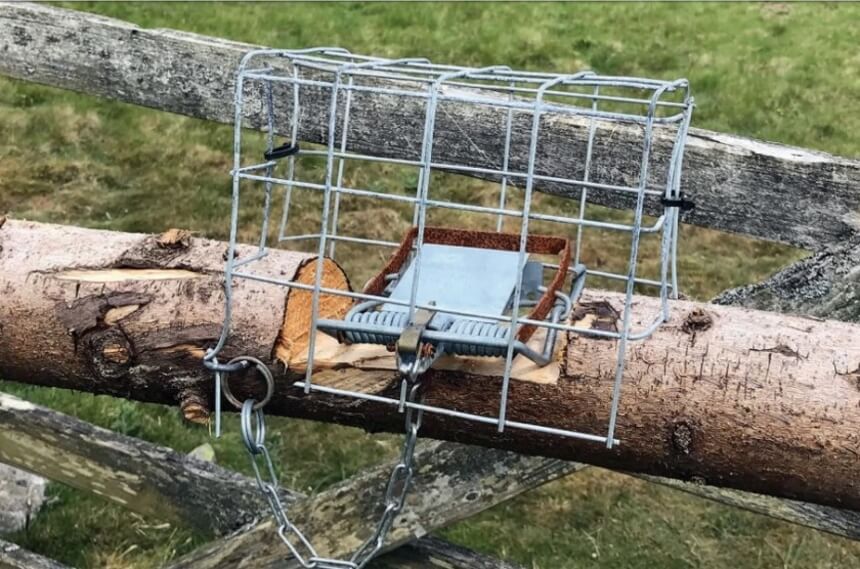
Like with poisons, you’ll have to dispose of the corpse. You’ll also have to clean the trap before you use it again. On the upside, you know when you’ve killed one of the pests, and you won’t have to look for it.
Useful Products to Check Out
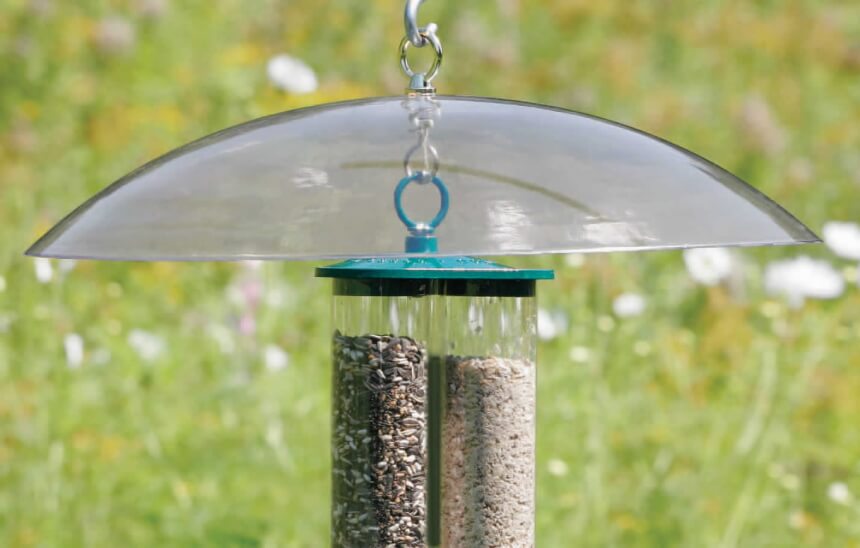
Inside your home, squirrels get everything they could ever wish for. This includes a close food source, protection from owls and other predators, and protection from various weather elements. As such, the big crack on your wall is more like an invitation for them to move in. To prevent them from taking advantage of that, you need to eliminate any such openings.
Inspect your home for cracks and holes in the siding. Where damage is more extensive, you may want to call in a repair technician.
Pay particular attention to the area closest to the ground and the roofline. If the damage isn’t too bad, you can probably get away with using a combination of copper mesh and expandable foam. The wire will prove impossible for squirrels to gnaw through.
The foam will keep water and dust out. Anything the squirrel can use to climb up the side of your house, such as thin pipes, could also be a problem.
Available food will also encourage the squirrels to return to your property, so removing any accessible snacks should go a long way in preventing infestation. While you may think they’re only attracted to the food in your house, even what you throw away in the trash can prove quite attractive.
Consequently, it’s prudent to inspect and properly seal any outdoor trash cans. You should also wash them occasionally to prevent the smell from inviting the rodents. Similarly, sealing fruits and cooked food before throwing them away will prevent the smell from escaping. Lastly, collect any fallen fruits from the trees in your yard.
If you have pets or bird feeders on your property, you’ll need to take extra care. Bag up the pet food once your furry friend is done eating and seal it before the next meal. Also, try to use bird feeders that are less accessible to squirrels. If you only put them on a tree, they should be pretty easy for the squirrels to reach.
If not, the best squirrel baffles in the market help block the squirrels from accessing the seeds and food in bird feeders.
Also, squirrels need water like most other mammals, and even if your property doesn’t have food, they might come for a drink. Therefore, you should remove any standing water, and this will also go a long way in preventing mosquito infestation. Often this involves making sure trash is well sealed and the yard is well graded for drainage.
Make sure to inspect after rain to identify areas and décor items that allow water to pool so you can correct the situation.
If you’ve tried everything, including pest repellents, kill methods, and preventive measures, yet there is still no end to the squirrels, it may be time to call in a professional. Professional pest control experts know the right chemicals, traps, and other solutions for the best results. Also, if they’re trapping them, they might have a predestined release area to work with.
You can also call in a professional if you want a quick resolution to your situation without trying all the countermeasures listed above.
The best way to get rid of ground and tree squirrels in the house is to use a couple of countermeasures concurrently. This includes eliminating water and food sources, cleaning out your attic, and using sound and pets to scare them out. Once you’re sure they’re out, you can block the entryways and use other repellents to ensure they don’t come back in.
As for the attic, you need to clear it of clutter, so the creatures don’t have anywhere to hide. However, before that, you should leave the lights on and possibly a speaker or ultrasonic device to get the critter to leave. Be sure to eliminate entryways into the attic as well. Alternatively, you can trap and release them in the wild or use poison and kill traps.
If the squirrel is inside your wall, you have to lure it out. Often that involves bait and a trap. It should be impossible to chase them out of walls since you’re too big to fit in there. Remember to seal any openings once the first one is out, so another squirrel doesn’t make a home there.
You can prevent access if you don’t like the squirrels scampering on your roof. To do so, you might have to cut the branches on the trees in your yard. Squirrels can easily jump 8 to 10 feet. However, if the distance between the nearest tree and your roof is longer, they won’t reach it. Of course, you’d also have to eliminate any ways the squirrel can climb up the side of your house to the roof.
The best way to get rid of squirrels in the garden is to use a multi-step process. You’ll often have to employ most of the steps mentioned above, including repellents and physical barriers. Choosing to call in a professional will also allow you a quick resolution to the issue without much fuss.